Sample photos
- Wide angle picture
| Overview | |
|---|---|
| Type | Digital Camera |
| Lens | |
| Lens | 28 mm–100 mm f/2.8–f/5.3 |
| Sensor/medium | |
| Sensor | 1/1.8" CCD |
| Maximum resolution | 3264 × 2448 (8.0 megapixels) |
| Film speed | ISO 50, 100, 200, 400 |
| Storage media | Secure Digital card |
| Focusing | |
| Focus modes | Auto and Manual |
| Exposure/metering | |
| Exposure metering | Evaluative, Center-Weighted Average, Spot |
| Flash | |
| Flash | Internal |
| Shutter | |
| Shutter speed range | 1/1500 sec–15 sec |
| Continuous shooting | Approx. 1.8 frame/s |
| Viewfinder | |
| Viewfinder | Optical, LCD |
| Image processing | |
| White balance | 6 positions & manual preset |
| General | |
| LCD screen | 2.5" |
| Battery | Canon NB-2LH/NB-2L Li-Ion |
| Weight | 225 grams (7.9 oz) |
| Chronology | |
| Replaced | S70 |
| Successor | S90 |
The Canon PowerShot S80 is an 8.0 megapixel digital camera originally released in 2005. The PowerShot S80 is the successor of Canon PowerShot S70 . At introduction, its MSRP was US$599. [1]
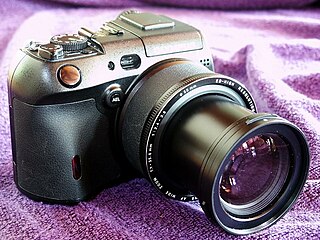
The Olympus C-8080 WZ is a digital camera formerly manufactured by Olympus. It was first announced on the opening day of the 2004 Photo Marketing Association Annual Convention and Trade Show. At the time, the C-8080 was set to be Olympus’ first eight-megapixel digital camera for the high-end consumer market. The MSRP was $1,149 USD.

A digital single-lens reflex camera is a digital camera that combines the optics and the mechanisms of a single-lens reflex camera with a solid-state image sensor and digitally records the images from the sensor.

The Canon PowerShot G is a series of digital cameras introduced by Canon in its PowerShot line in 2000. The G series cameras are Canon's flagship compact models aimed at photography enthusiasts desiring more flexibility than a point-and-shoot without the bulk of a digital single-lens reflex camera.

The PowerShot Pro1 is a digital camera made by Canon, announced in February 2004 and was discontinued first quarter of 2006. It uses a Sony-built 2/3 in (17 mm) 8.3 megapixel CCD image sensor, which gives a usable image size of approximately 8.0 megapixels. It was the most expensive fixed-lens camera sold by Canon at the time, and thus the top of the PowerShot range. It was the first fixed lens designated a Canon L series lens, a designation normally reserved for the professional lines of their FD, EF, and RF lenses for interchangeable lens cameras.
The Leica Digilux 1 is a digital camera developed in partnership with Panasonic, which was released in 2002, roughly the same time as the Canon PowerShot G2 and the Nikon 2000. It is the second of Leica's digital offerings. Where the original Digilux was developed in partnership with Fuji Camera, the Digilux 1 was developed jointly with Panasonic; Leica is responsible for optics, while Panasonic designs the camera electronics. According to Leica, this allows both companies to design cameras that creates a harmonious matching of lens to sensor to produce color and contrast to Leica standards.
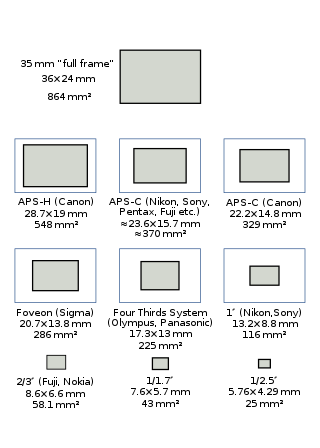
A full-frame DSLR is a digital single-lens reflex camera (DSLR) with a 35 mm image sensor format. Historically, 35 mm was one of the standard film formats, alongside larger ones, such as medium format and large format. The full-frame DSLR is in contrast to full-frame mirrorless interchangeable-lens cameras, and DSLR and mirrorless cameras with smaller sensors, much smaller than a full 35 mm frame. Many digital cameras, both compact and SLR models, use a smaller-than-35 mm frame as it is easier and cheaper to manufacture imaging sensors at a smaller size. Historically, the earliest digital SLR models, such as the Nikon NASA F4 or Kodak DCS 100, also used a smaller sensor.
The Kodak EasyShare V570 was a 5-megapixel digital camera manufactured by Eastman Kodak. Announced on January 2, 2006, it was an upper-end model in the consumer price range, advertised at $400 in the United States in January 2006. It had an innovative dual lens system, combining two periscopic groups each with its own sensor: one very wide angle equivalent to a 23 mm in 135 format and a 3X zoom equivalent to a 39–117 mm, totalizing a virtual 5X zoom, with a step between 23 and 39 mm. It is the first dual lens digital camera. The model won a gold medal in the 2006 Industrial Design Excellence Awards.
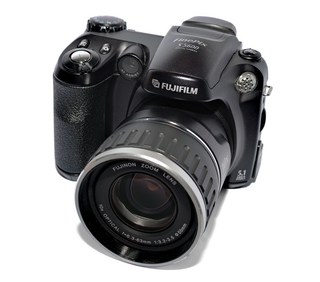
The Fujifilm FinePix S5200,, is a bridge digital camera made by Fujifilm. The camera's original MSRP was USD $285.
General Imaging was a manufacturer of digital cameras headquartered in Torrance, California, established in 2006 by Hiroshi "Hugh" Komiya, a former executive of Olympus Corporation. General Imaging sold their cameras internationally under the General Electric name, used under license. General Imaging was licensed to manufacture and sell their cameras under the AgfaPhoto name in Japan. On October 5, 2015, General Imaging filed for bankruptcy.
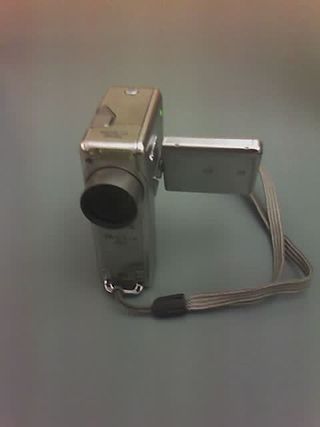
The Canon PowerShot TX1 is a Canon digital camera. It was released on February 22, 2007 The TX1 is a hybrid device designed for both still imagery and video recording. It offers both HDTV movie capture, as well as 10× stabilized zoom and 7.1 megapixel sensor. It is designed to improve upon hybrid offerings by competitors such as the Sony Cyber-shot M1, Sony Cyber-shot M2, and Pentax MX4. It is oriented vertically and uses the camcorder-like swivel LCD viewing screen. Canon compares the hybrid camera's size to that of the Canon ELPH series of cameras. The company distinguishes the camera for its optical image stabilizer technology, DIGIC III image processor, face detection technology and red-eye effect correction with a mention of its built-in lens cover and scratch-resistant, anti-reflective LCD screen.
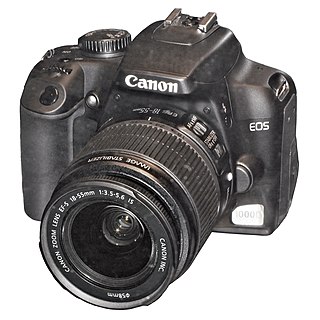
Canon EOS 1000D is a 10.1-megapixel digital single-lens reflex camera announced by Canon on 10 June 2008 and started shipping in mid August 2008. It is known as the EOS Kiss F in Japan and the EOS Rebel XS in the United States and Canada. The 1000D is an entry-level DSLR that has been described as being a step below the 450D.

The Canon PowerShot S90 is a high-end 10.0-megapixel compact digital camera originally announced in 2009. The PowerShot S90 is the successor of the Canon PowerShot S80.
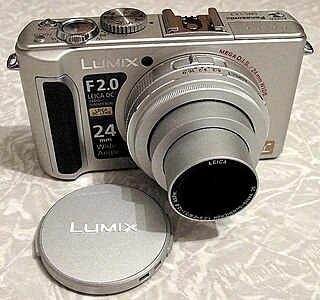
The Panasonic Lumix DMC-LX3, or LX3, is a high-end compact "point and shoot" camera launched by Panasonic in late 2008 to succeed the Lumix LX2.
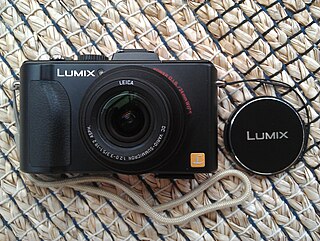
The Panasonic Lumix DMC-LX5, or LX5, is a high-end compact "point and shoot" camera launched by Panasonic in 2010 to succeed the LX3.
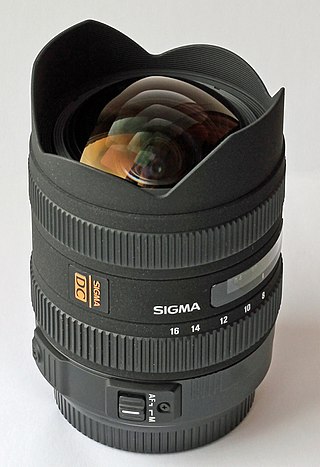
The Sigma 8–16mm lens is an enthusiast-level, ultra wide-angle rectilinear zoom lens made by Sigma Corporation specifically for use with APS-C small format digital SLRs. It is the first ultrawide rectilinear zoom lens with a minimum focal length of 8 mm, designed specifically for APS-C size image sensors. The lens was introduced at the February 2010 Photo Marketing Association International Convention and Trade Show. At its release it was the widest viewing angle focal length available commercially for APS-C cameras. It is part of Sigma's DC line of lenses, meaning it was designed to have an image circle tailored to work with APS-C format cameras. The lens has a constant length regardless of optical zoom and focus with inner lens tube elements responding to these parameters. The lens has hypersonic zoom autofocus.

The Canon EOS 80D is a digital single-lens reflex camera announced by Canon on February 18, 2016. It has the same body-only MSRP as the Canon EOS 70D, which it replaces. The camera can be purchased as a body-only, as kit with the 18-55mm IS STM lens, with the new 18-135mm IS USM lens or with the EF-S 18-200mm IS. As a part of the Canon EOS two-digit line, it is the successor to the EOS 70D and is the predecessor of the EOS 90D.
The Pixel 3a and Pixel 3a XL are a pair of Android smartphones designed, developed, and marketed by Google as part of the Google Pixel product line. They collectively serve as mid-range variants of the Pixel 3 and Pixel 3 XL. They were officially announced on May 7, 2019 at Google I/O, seven months after the announcement of the original Pixel 3 lineup, and were released on the same day. On August 3, 2020, it was succeeded by the Pixel 4a.

The Canon EOS 90D is a digital single-lens reflex (DSLR) camera released by Canon on August 28, 2019. It has a body-only MSRP of US$1199, which is the same as the Canon EOS 80D, which it replaces.

The Canon EOS R3 is a 24 megapixel full-frame mirrorless interchangeable-lens camera launched by Canon officially announced by Canon on 14 September 2021 alongside two RF mount lenses. The camera is available as body only with a MSRP of US$5,999.00.
![]() Media related to Canon PowerShot S80 at Wikimedia Commons
Media related to Canon PowerShot S80 at Wikimedia Commons